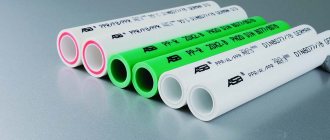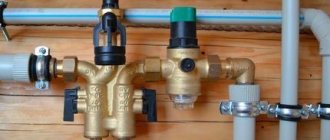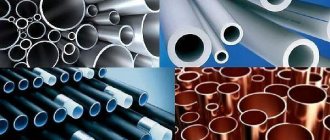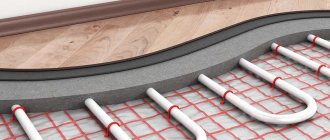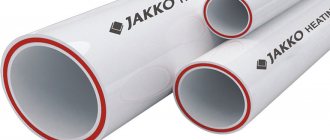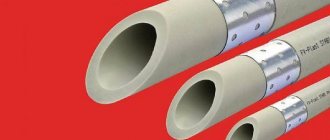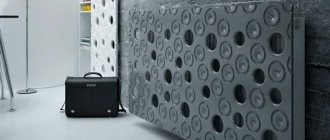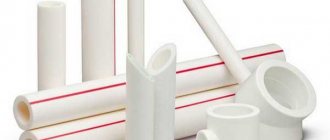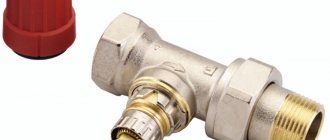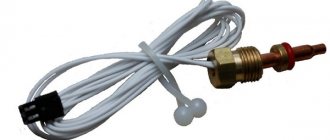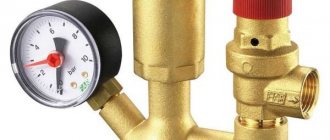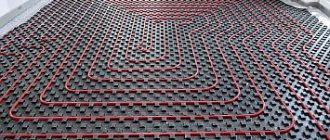Currently, polypropylene pipes for heating are becoming the most popular material. And this is not only due to their aesthetic appearance - the reasons for their success lie in the ease of installation and durability of operation.
Polypropylene pipes for heating
Today, specialized stores offer a considerable assortment of polypropylene pipes, from which you can choose the type and color that is most suitable for a particular heating system. Such pipes have their advantages and disadvantages, as well as features in installation work. You need to know all this information - they will definitely come in handy when choosing, installing and operating a heating system with a polypropylene pipeline.
Which type of polypropylene pipes last longer?
The propylene material from which the pipes are made is a chemically inactive polymer supplied to production extrusion lines in the form of high-quality granules. It is specially designed for the manufacture of plumbing accessories for various purposes - circulation of hot coolant, transportation of cold water, disposal of sewage waste, as well as laying communications for various chemical compositions, gas mixtures, etc.
Starting material - granulate
Propylene has excellent physical and technical characteristics and is easy to install, which is why the demand for products made from it is constantly growing. In addition to the pipes themselves, for each of their types, components are produced that are designed for the installation of almost all common components and connections - these are bends at various angles, adapters for different diameters and threaded connections, tees, plugs, valves, compensation loops and much more. . Propylene differs favorably from polyethylene, from which some types of pipes are also made, in that it can withstand higher coolant temperatures while having greater rigidity. Such pipes are produced in various sizes - depending on their purpose, it varies from sixteen millimeters to one hundred and ten. All types of propylene pipes have the same characteristics: their thermal conductivity is 0.24 W/m C, weight (specific) is 0.9 g. per 1 cm³ (they are lighter than water), elasticity is 900 N/mm², material viscosity is 22 kJ. The main method of installing polypropylene pipes is thermal welding (soldering), although in individual components of the heating system design one cannot do without threaded connections.
China
The products of most Chinese enterprises are not of good quality. The building materials market is no exception. But there are two companies worthy of attention.
BLUE OCEAN
The Blue Ocean International Holdings group of companies (UK) is currently one of the largest producers and exporters. Products under this brand are sold in 42 countries. Production is located in China.
The market offers a full range of unreinforced and reinforced pipes for the installation of cold, hot water supply and heating pipelines. Pipes and fittings are manufactured with diameters from 20 to 160 mm for operating temperatures up to 60°C and pressures up to 1.0 MPa.
The manufacturer claims thermal versatility and the ability to use pipes for coolant with temperatures up to +95°C.
The main advantage of Blue Ocean products is their relatively low price. Among the shortcomings, one can note the heterogeneity of the color of the pipes and different shades of color in the batch, as well as a large number of fakes of this brand.
DYZAIN
A large range of unreinforced and reinforced polypropylene pipes is presented by DIZAYN Grup. The product is produced in strands and in coils of two colors - gray and white. The product line is complemented by a wide selection of fittings, fasteners, feedthroughs and tools.
Good quality and reasonable price are the main advantages of this brand.
Types of produced polypropylene pipes
Depending on the type of feedstock used in the extrusion production of pipes, they are divided into three main classes:
- The first of them is most often used for industrial water supply lines and ventilation systems. PP RRN - this is how this material is labeled, and it is made from homo-propylene.
- The second type is used for installing household water distribution systems and for underfloor heating systems - it is marked PPR RV and is made from a block copolymer.
- The third type is used when installing heating systems - they function perfectly due to the evenly distributed load on the internal surfaces of the pipes. The PP RRV marking code is applied to them, and similar products are made from stat copolymer.
The operating temperature of all three types of these pipes should not exceed 70-75 degrees. If this condition is met, they will function for a long time without causing problems. In addition, propylene pipes can have a monolithic structure, or be reinforced with reinforcement. For heating, propylene pipes reinforced with fiberglass or aluminum foil located in the thickness of the walls are most often used. Therefore, when carrying out installation welding work, there will be no need to strip the surface layer, which is typical for the installation of other types of pipes - with external reinforcement.
Price
Approximate prices per linear meter for PN25 pipes reinforced with glass fiber:
- Fora Ø 25 — 92 rub.
- Metak Ø 20 x 3.4 – 118 rub.
- Ø 25 x 4.2 – 181 rub.
- Ø 32 x 5.4 – 317 rub.
PN25 Aluminum reinforced products cost:
- Ø 20 x 3.4 mm – 58 – 78 rub.
- Similar for 25 mm - 80 - 110 rubles.
- Ø 32 – about 125 rub.
The use of PN20 products for heating is not advisable, but is possible in gentle conditions.
The cost of PN20 compared to PN25 is about a third lower (with similar diameters).
If you need to buy PP-RCT PN25, the prices will be as follows:
- Ø 20 – approx. 90 rub.
- Ø 25 – approx. 130 rub.
- Ø 32 – approx. 197 rub.
So. The best pipes for heating are PPR, or PP-RCT. It is most correct if it is a reinforced version (fiberglass, or aluminum). Pressure design - PN 25 (or S 2, SDR 5). Temperature – 90 °C, and size – according to calculation (most often from 25 to 32 mm).
PP pipes have long been used instead of cast iron and steel products, and quite successfully replace them. Polypropylene pipes for heating: technical characteristics, as well as the advantages and disadvantages of this type of product, read on.
You will learn which pipes are best to choose for organizing a ventilation system in a private home by reading this article.
Do polypropylene pipes have any disadvantages?
Polypropylene pipes have much fewer disadvantages than advantages, but they certainly need to be known and taken into account when choosing. Thus, one of the negative qualities of propylene pipes can be considered the expansion coefficient of the material - it is quite high. When exposed to high temperatures, the pipeline may begin to sag, so propylene pipes with mandatory aluminum reinforcement are used for heating systems and hot water supply. It should be noted that the material manifests itself in this way when heated above 60 degrees, and the standard coolant temperature in the central heating system is set at 70 degrees.
The undeniable positive qualities of polypropylene pipes
The positive qualities significantly outweigh the disadvantages of propylene pipe. These include:
— complete neutrality of the pipes to the chemical composition of the coolant and to external influences;
- long guaranteed service life, not comparable to any other material, which constantly interacts directly not only with ordinary water, but also with the coolant, which often contains aggressive chemical additives;
— high level of strength and elasticity (even when the material is stretched, it is not damaged, but allows it to bear significant loads during active use);
— an important factor for many buyers is the low price, which is affordable to almost everyone;
— light weight of pipes, which allows them to be transported independently, without the involvement of freight transport;
— quick and easy installation of the system, which can be performed by one person, provided the necessary tools are available;
— pipes with aluminum reinforcement can withstand temperatures from -45 to + 90 degrees;
— the polymer is absolutely not susceptible to corrosion, so the water transported through such pipes will never be saturated with rust and hardness salts;
- in an autonomous circuit made of propylene pipes there is almost no oxygen - this prolongs the life of the batteries installed in this circuit;
— due to the fact that when installing such pipes, you can use almost every fragment of them, even a very small one, the installation turns out to be waste-free, and therefore very economical;
— the aesthetics of propylene pipes helps the heating system fit perfectly into any interior.
Accuracy of wiring is one of the main advantages
Such pipes easily fit into any interior
Türkiye
Turkey, one of the first countries producing polypropylene pipes, conquered the Russian construction market. Among Turkish manufacturers, the most recognizable are TEBO, PILSA, VALTEC, KALDE, JAKKO.
TEBO
TEBO technics polypropylene pipes comply with all European standards and have a number of competitive advantages:
- High quality raw materials supplied from Germany and South Korea;
- Wide range of models;
- Long service life;
- No marriage.
A wide range of pipes and related materials provide a full cycle of installation operations for engineering communications for any purpose. The TEBO technics brand produces pipes with diameters from 20 to 160 mm, fittings, manifolds, shut-off valves and components. The service life of products for hot water is 30 years, for cold water - 50.
In addition to conventional PP pipes, the model range has been expanded to include reinforced pipes. Pipes reinforced with aluminum have a minimal coefficient of linear expansion. Fiberglass provides increased lateral stiffness.
PILSA
The most famous brand among professional builders. PILSA Plastik Inc. widely represented in 50 countries around the world. PILSA Plastik Inc is part of the Wavin industrial group, the largest European manufacturer of polypropylene products. Of particular interest to consumers is the versatility of using Pilsa pipes at temperatures from -10°C to + 95°C. The elastic material prevents frozen water from destroying the pipes.
Pilsa brand products have a number of advantages:
- Low thermal conductivity;
- High heat resistance;
- Good throughput;
- Pipes and connections do not require maintenance;
- Attractive appearance.
The range of pipes and additional elements is perhaps the richest of all possible. Excellent quality and low price guarantee the company great demand among customers.
But popularity carries with it danger. In the markets you can find fakes from Chinese handicraft workshops.
VALTEC
VALTEC offers consumers single-layer and multi-layer pipes and fittings made of high-strength polypropylene PPR-100 with diameters from 20 to 110 mm. The pipes are intended for drinking and domestic cold and hot water supply systems, as well as for process pipelines transporting non-aggressive liquids and gases. The company produces multilayer polypropylene pipes VALTEC PP-FIBER, reinforced with glass fiber and PP-ALUX - aluminum foil.
The form of delivery of pipes is 2 and 4 meter sections. A fairly modest set of fittings and shut-off valve elements.
The construction market reacts sluggishly to the products of this brand.
KALDE
KALDE is well known for its quality products. The line is represented by unreinforced, aluminum and fiberglass reinforced pipes with a diameter of 20 to 110 mm.
Advantages of KALDE reinforced pipes:
- Reduction of linear expansion by 75%;
- Increased throughput by 20%;
- High impact strength at low temperatures;
- High stability.
All pipeline elements are made of white and gray polypropylene.
The range of fittings includes polypropylene, combined with metal, threaded brass, compression and press fittings. In addition to pipe products, there is no shortage of manifolds, wall kits, ball valves and valves on the market. The manufacturer offers coarse filters, equipment for installation and welding.
JAKKO
Jakko was founded in 2002 in Kazakhstan as a joint venture with Turkey. The company quickly established a wide dealer network in the CIS and ensured the supply of high-quality products. In 2006, it switched to its own production in Turkey.
This brand produces a standard set of polypropylene products in the diameter range from 20 to 125 mm. The brand is little known, the products are little studied, and the reviews are contradictory. For this reason, it is very difficult to recommend Jakko products. Practitioners refer to the identity of Jakko products in terms of quality and range of related materials with VALTEC. And here the price of products in a particular region can play a decisive role.
How to connect polypropylene pipes?
Working with any propylene pipes is easy and simple; connecting them by soldering or threaded connections, when required, is not particularly difficult, and anyone can learn how to do this. The material is cut with special scissors or a hacksaw, and the pipes are connected to each other by auxiliary connecting parts and soldering. Soldering is a fairly reliable connection - such lines can easily be embedded in walls without fear for their integrity. If the threaded joints of metal pipes were the weakest point in the heating system and required careful “packing”, then the advent of propylene products and the method of connecting them - high-quality soldering - eliminated this problem forever.
Work process
Installation by soldering is quite easy if you use high-quality tools and clean, non-defective connecting parts. An important condition for quality installation is maintaining the required temperature. For each specific pipe diameter, a specific soldering temperature must be applied. If the pipes were outdoors or in a room with low or high temperatures, they must be kept indoors for at least 12 hours to adapt them to the conditions in which they will be installed.
Tools
Mounting kit
For installation work, you will need special tools, and some of them cannot be replaced with other available devices:
1. A machine for welding propylene pipes, having nozzles (couplings and mandrels) of different standardized diameters.
Welding machine in working position
2. Scissors for cutting pipes - if you don’t have them, a hacksaw or jigsaw will do.
3. Folding meter and tape measure, as well as a marker for marks.
4. A sharp knife for cleaning the ends of pipes after cutting them from burrs and shavings. In addition, for these purposes, for trimming, you can use a special tool - a shaver, with properly sharpened and aligned knives.
5. In addition, it is necessary to have a pre-compiled and carefully thought out heating circuit diagram.
Installation
- When starting work, you need to keep the drawn up diagram before your eyes at all times and, based on it, prepare individual parts of the outline. To do this, it is better to lay out the pipes along the walls along which the lines will run, and, measuring on site, prepare individual parts.
- Having prepared the pipes in a certain area, install the required nozzle on the welding machine and heat it to the required temperature, which depends on the diameter and type of material. Most modern welding machines have extremely clear gradations on the built-in thermostat.
- Next, a connecting element is tried on the pipe - it can be a coupling, tee, elbow, tap, or other shaped products.
Variety of shaped elements
- To control, use a marker to make a mark on the penetration depth. The pipe should not go into the joint too deeply, but should be held tightly in it. If it is a straight coupling, then there is a protrusion inside it that will stop the pipe in the right place.
The process of heating the mating parts
- The shaped connecting element and the end of the pipe are placed respectively on the mandrel and coupling of the welding machine, so that they heat up simultaneously, and the required heating time is noted, which depends on the size of the pipe diameter and the thickness of its walls. After waiting the required interval, the parts are removed from the nozzles of the device, then the pipe is progressively inserted into the coupling - no screwing movements should be made. The penetration depth and holding time are given in the table:
Parameters taken into account when welding polypropylene pipes
The fastened parts must cool down - this happens quite quickly (the data is also given in the table).
Attaching pipes to the wall
To attach pipes to the wall, special fasteners are provided (they are often called clips); they are selected according to the diameter of the pipes and must fit exactly to them. There are fasteners that firmly fix the position of the pipe and ensure its stable location. They also use movable fixing fasteners; in some places you can’t do without them, for example, on long sections where pipes are subject to significant thermal expansion; take this into account not only when choosing the fastening material, but also the frequency of their use.
Fastenings - clips
Holder fasteners help pipes withstand loads in the event of increased pressure and protect them from sagging.
Video: tips for selecting polypropylene pipes for heating
If you have to install or replace a heating circuit, one of the best decisions will be to choose polypropylene pipes as the main coolant transporter. The main thing is to take into account all the characteristics described above and follow the installation technology. Do not rely heavily on the advice of sales consultants in stores; sometimes they advise an unknowing buyer exactly what knowledgeable specialists do not buy. If you are armed with knowledge, you will not be able to deceive, because you will not deceive yourself!
Czech
The Czech Republic is represented on the domestic market by Wavin Ekoplastik and Fv Plast
Wavin Ekoplastik
The Czech company Wavin Ekoplastik uses random, a PP-R copolymer, for cold water supply pipes. And for heat-resistant pipes - high-quality heat-stabilized PP-RCT, similar to those from German manufacturers.
The products of this company are in demand in the domestic market due to high quality fittings and shut-off valves. Additional components allow you to lay a pipeline of any configuration. The price of Wavin Ekoplastik products is not much different from their German counterparts, and their reliability is not inferior to them. The only disadvantage of products from the Czech Republic is the not very attractive gray color of the products, which requires decoration.
Fv Plast
FV-Plast pipes are inferior to Ekoplastik in popularity due to the poorly developed dealer network in our country. The quality is no worse than that of its closest competitor. The pipes of this company are designed for use in cold and hot water supply pipelines, underfloor heating and heating systems.
It is necessary to note the exceptional lightness of FV-Plast pipes, which facilitates the installation of heated floors.
The FV-Plast company has made the production of reinforced polypropylene pipes a priority. The technology involves reinforcement with aluminum foil and fiberglass.
The manufacturer has provided a wide selection of related parts: fittings, shut-off valves and pipe fastening systems.
Conclusion: Having examined both options for Czech pipes, we can state that they do not differ in quality from German ones, and the price is still lower. The only indicator in which they are inferior is the fairly large coefficient of thermal expansion of unreinforced pipes.
